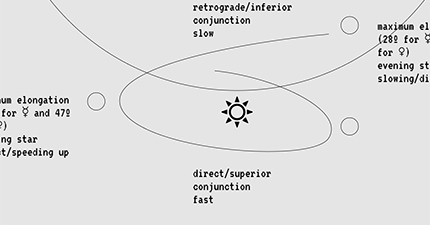The Aries Point is the fame point. According to Noel Tyl and Robert Hand, it shows how someone can become famous. Let’s take a deeper look and see what it’s really made of.
The Aries Point, abbreviated AP, is the intersection between the equator and the ecliptic. If you know anything about declinations, you’ll know that planets tend to move out of bounds (exceeding 23º27) when they are in the signs of Cancer or Capricorn. That’s because, when in Cancer and Capricorn, planets are the furtherest that they can be from the equator by north or south, or latitude, motion. In contrast, planets are closest to the equator when they’re in the signs of Aries and Libra. This “z-axis” is usually unseen in a natal chart, which only has two dimensions.
The Aries Point, then, is any point that makes a 0º, 90º, or 180º angle to that point where the equator crosses the ecliptic. That’s the point where the sun is also at equinox. So, the AP is at 0º Aries, 0º Cancer, 0º Libra, and 0º Capricorn.
Robert Hand, in his book Horoscope Symbols, writes that the AP has been in use since the Greeks but that the Greeks used the point only in terms of the beginning of spring. Sure, it represented the start of spring and the end of winter but not necessarily anything to do with fame or worldly impact. Where did all that stuff come from?
In the 1920s and 1930s, the Uranian School of astrology theorized that a hierarchy of social relationships could be studied based on oppositional points: the lunar nodes represented intimate relationships, the ascendent and descendent speak to general relationships, and the AP symbolizes the widest social relations. This is why the AP tells us about fame, because it tells us how we are able to speak to the wider human collective. As Noel Tyl writes, “When the Aries Point is activated in a personal horoscope, there is the potential of public projection for the person in terms of the planet, point, or midpoint configured with it.” Robert Hand also writes that, “If one ever becomes famous or makes a significant impact on society outside one’s circle of friends and associates, it is through symbols that relate to the Aries Point.”
To properly look for relations to the AP, you’re not just looking for any planet that is at 0º degree of any cardinal sign but also for midpoints that make a hard aspect to the AP. For example, if your sun is at exactly 20º Pisces and your Venus is at exactly 10º Aries, then the midpoint of your Sun/Venus is equal to the AP. That means that, according to Noel Tyl’s technique, self expression (sun) and aesthetics (Venus) can bring you fame and give you the chance to impact the world. Likewise, someone with Jupiter at 3º Aquarius and Pluto at 27º Scorpio could possibly seek fame through political (Jupiter) power (Pluto). Of course, since the AP is not a planet, there is no orb. Calculations to the AP are only valid if there are less than one degree away from 0.
However, for this article, I’m only going to talking about people whose suns are conjunct the AP. This is both because it’s easier to calculate and because I’ve noticed some interesting patterns.
0º Aries: Louis Sachar, Slavoj Zizek, and Lois Lowry (Anti-Ideological, Anecdotal, Antisocial)
All of these writers have Suns conjunct 0º Aries. Both Louis Sachar and Lois Lowry are children’s book authors. Sachar is responsible for his book, Holes, and the Wayside School series. Lowry’s most famous trilogy includes The Giver, Gathering Blue, and Messenger. Both of these guys were born on March 20th, making their suns a bit over the 30 minute mark of 29º Pisces. Rounded up, their suns are conjunct the AP since they’re less than 30 minutes away.
On what may seem like the other end of the spectrum is Slovenian philosopher and Marxist Slavoj Zizek, who was born on March 21st and has sun at 0º Aries and some minutes. Zizek has written more than 60 books but his topics are mostly about Hegel and Marxism.
Zizek, as a political philosopher, is notorious for being anti-ideological. The example he gives of ideology in today’s society, as opposed to the 20th century one, is the belief that one can protect oneself from capitalism by not truly believing in it while engaging in it through behavior. Zizek says that the opposite of ideology is not reality and gives a few examples: in Nazi Germany, one of the biggest Nazi fears was that attractive Jewish men were fooling around with German girls. Zizek says that, if you choose to argue with the Nazi and say that Jewish men are not sleeping with German girls, that you have already lost. Rather, he says that the Nazi is ideologically paranoid not because he believes something that isn’t true but because of the degree of his obsession. Even if Jewish men were sleeping with German girls, the ideology of the Nazi is still pathological.
Neither Sachar nor Lowry make their stories supportive of any one ideology. In the Hollywood adaptation of The Giver, rhetoric makes it seem as if Jonas chooses to leave his colony because he is disturbed by the lack of free choice in his society but, in the original book, the question of choice vs authoritarianism doesn’t bother him at all. Rather, what makes Jonas leave his colony is the feeling that babies should not be separately from their biological families. Jonas has no political sentiments and we don’t experience his society in an ideological capacity. Rather, he only acts on the base desire to preserve life.
In Holes, it is revealed that Stanley and Zero’s great-great-great ancestors knew each other and Zero’s ancestor placed a curse on Stanley’s ancestor. Throughout the book, whether or not Stanley’s family is actually cursed or whether that’s just something that his family blames their problems on is subject to much debate and never answered. If the belief in a curse stands for ideology, then the characters in the book are bound by their belief in ideology, often do not believe in ideology, and make fun of themselves for believing in ideology.
When looking at the writing of Lowry, Sachar, and Zizek closely, it appears they have more in common with comedians than moralists. Holes, The Giver, and most of Zizek’s dirty jokes are enjoyable because they make their point without developing any morals along the way. And they oppose ideology not through trying to describe reality but through fast stories that are hard to believe. Sachar, Lowry, and Zizek’s storytelling is anecdotal, full of convoluted coincidences, and almost anti-belief. In fact, the lack of suspension of belief is exactly what make Lowry become so criticized. In Zizek’s dirty jokes or Sachar and Lowry’s stories, you get the feeling that someone is pulling one over on you. You don’t believe them at their word. However, you’re along for the ride anyway.
0º Cancer: Meryl Streep, Lana Del Rey, Prince William (Nationalism, Character Types, Performance)
All throughout my childhood, all I heard about Meryl Streep was that she can play any role. And Streep famously made her career by refusing to be typecast. This means that she will play your everywoman, your devil in Prada, your crazy white mother, and so on. Streep stands for a certain range of expressions at a time when actors in Hollywood were expected to become images strongly associated with one character archetype and only that one character archetype. However, a closer look at Streep’s career shows us that Streep’s roles were really about the versatility of struggling against one type of womanhood—white womanhood. Whether she plays your racist, smart mouthed mother or your successful career woman who has a marriage that is failing due to her careerism, Streep is playing out certain archetypes that white women fear in their lives.
Though Lana and Prince William are not actors by profession, both of these people have careers that rely on their performance of character archetype. Both of them also perform character archetypes that strongly relate to a type of postmodern branded nationalism. Lana’s performance of an American sweetheart is sardonic. She wraps her appreciation of Americana and art deco in layers of irony and sings about how American power is only about money, power, and glory. She wonders whether this is the end of America and her answer that, no, it’s not, and that we’ll all keep on dancing, falls flat in an intentional way.
For Prince William, well, he’s a prince. The royal family in England has no real political power and is mainly a tourist attraction and symbol of some kind of national heritage that is often memorialized through souvenirs and televised when there are marriages or births. When he was younger, Prince William told his mother that he wanted to be a cop and his brother, Harry, told him that he couldn’t because he had to be king. Prince William would go on to have something of a military career but, of course, as he is the prince of England, all of this is just really part of his royal resume and the iconography of performing nationalism as a postmodern prince.
Here is where it gets interesting. A big part of why Meryl Streep was said to be an amazing actor was because, in her early career, she was really good at accents. To audiences, it appeared that Streep was a woman who could become any nationality at all, not just American. Thus, while Lana’s performance as American sweetheart and Prince William’s performance of modern British nationality are rather contained into one nation-state as character archetype, Streep is able to perform not just one type of nationality but nationalism itself. By making nationality a matter of affect, she naturalizes nationalism.
There are push-backs, of course. Your Sun sign is the sign that you struggle against. Prince William dislikes the media because of what happened with his mother. Lana grew up during the Bush Years and her performance of American power is convoluted. However, it does appear that there is a relationship between 0º Cancer, nationalism, and character performance.
0º Libra: John Coltrane, Bruce Springsteen, and Ani DiFranco (Ideological, Folksy, Lyrical)
The most obvious trait that all of these people share is that they are all musicians. Since 0º Libra is the point directly opposite 0º Aries, it appears as if the people with Sun signs conjunct 0º Libra are also writers, as the people at 0º Aries are. It’s just that they write in music rather than prose. Instead of writing literally, Coltrane, Springsteen, and DiFranco are all writing lyrically and metaphorically.
The other notable thing about all three of these musicians is that their music spoke to people who share the musicians’ own identities. John Coltrane was at the forefront of jazz, Springsteen wrote music for the working class, and Any DiFranco writes music about feminist issues.
Now, also in contrast to what was happening on the 0º Aries side of things, folks over here on the 0º Libra side of things are ideological. Coltrane explored musical harmonies through spirituality. He experimented with Kabbalah, The Tibetan Book of the Dead, Zen Buddhism, and believed that by studying different frequencies that he could control emotional and social forces. Coltrane believed in the social power of his music are a literal force, as a set of harmonies and frequencies that could potentially cure disease or invoke weather patterns.
Springsteen and DiFranco are also ideological lyricists. Springsteen became known for his pacifism during the Vietnam era, supported liberal political figures, preaches about tolerance, and does music for LGBTQ activism. DiFranco is open about her bisexuality, writes songs about her abortions, and has also actively supported candidates for presidential office as well as anti-death penalty and environmental issues.
In stark contrast to the non-ideological specimens on the Aries side of things, these 0º Libra people are incredibly involved in political and religious institutions. You can’t really see any of the people of the Aries side of things speaking out in support of any politician or ideology. You only really see them speak out in critique. However, folks on the Libra side are constantly speaking out in support of the policies, movements, and beliefs that they want their audiences to join together and move through. Coltrane, Springsteen, and DiFranco are all much more involved in positive politics rather than negative politics. You get the sense that they’r not here to blow holes in things but to build things that they believe are worth having. That’s why their music speaks to people, because it’s meant to be a social force that means folks together.
0º Capricorn: Jean-Michel Basquiat, Jean Racine, Ralph Fiennes (Historical, Universal, Scripted)
If 0º Cancer was all about performative nationalism, then 0º Capricorn is all about performative history. If 0º Cancer is about performing pre-scripted character types, then 0º Capricorn is about the performative act of scripting.
Jean Racine is the earliest of these figures. He was a French playwright in the 17th century. Most of what Racine is known for is his involvement in the classical revival in French drama. Racine studied Greek and Roman tragedies and brought them back to life in his contemporary day France, reviving 17th French culture with classical sources. Likewise, Ralph Fiennes (who is most famous for playing Voldemort in the Harry Potter franchise), is a Shakespeare scholar. As a British actor, Fiennes explores the foundation of British drama through his independently produced and acted Shakespeare drama. He has a whole thing where he performs Shakespeare for kids. Basquiat, who was born in Brooklyn in the 1960s, went to the Brooklyn Museum often with his mother and, through those experiences, received a classical arts education.
If the performers on the 0º Cancer side of things saw themselves playing out these ready-made nationalist archetypes, then the folks on the 0º Capricorn side of things break up the specificity of that nationalism a bit and play with these huge, universal themes. Basquiat is famous for creating figures that he called heroes and saints in his paintings. He memorialized himself as a king. Racine memorialized the tragic figures of Greek and Roman theater by depicting aristocrats in his time period. Fiennes is most famous for playing a literal nazi in The Reader and for playing a metaphorical nazi in Harry Potter as Voldemort, nazism standing in for the great villainous archetype of the 20th and 21st centuries.
While Fiennes is mostly an actor, when he does direct, he chooses to direct a Shakespeare play and bring a certain aspect of British history into the present day. Racine was mostly a playwright and spent all of this scripting. In terms of Basquiat, things are more complicated because he was an artist living in the day and age of Warholian superstardom, but when looking at the ways in which Basquiat cultivated his style and televised appearances, one gets the sense that he does pre plan how he is going to act and what he is going to do in order to project a certain image. Even Basquiat’s history with graffiti under the name of SAMO, which gives his a feeling of authenticity as an artist, coincides with the way that Basquiat sought out Andy Warhol in cafes in New York City and gave him pieces of his art. Basquiat had a plan for himself and that plan was not to be a graffiti artist but to become a museum artist with a place in history.
In Conclusion
I’m going to write more about this later on but it does seem like the 0º Aries—Libra axis is about language (literal and metaphorical, ideological and non-ideological, antisocial and folksy) while the 0º Cancer—Capricorn axis is about images (nationalist and historical, archetypal and universal, performative and scripted). This relates to the scheme of antiscia, under which signs that oppose one about across the Cancer—Capricorn solstice points are said to be confronting signs or signs that see one another while signs that are counter-antiscia or oppositional across the Aries—Libra axis are said to be signs that hear one another or perceive one another. I’ll make some diagrams and everything to go with that article so that you can see exactly what I’m talking about with antiscia and how those sign—sign relationships relate to what this article talks about.


